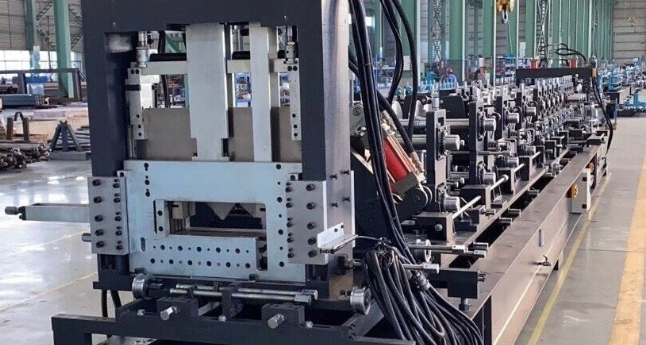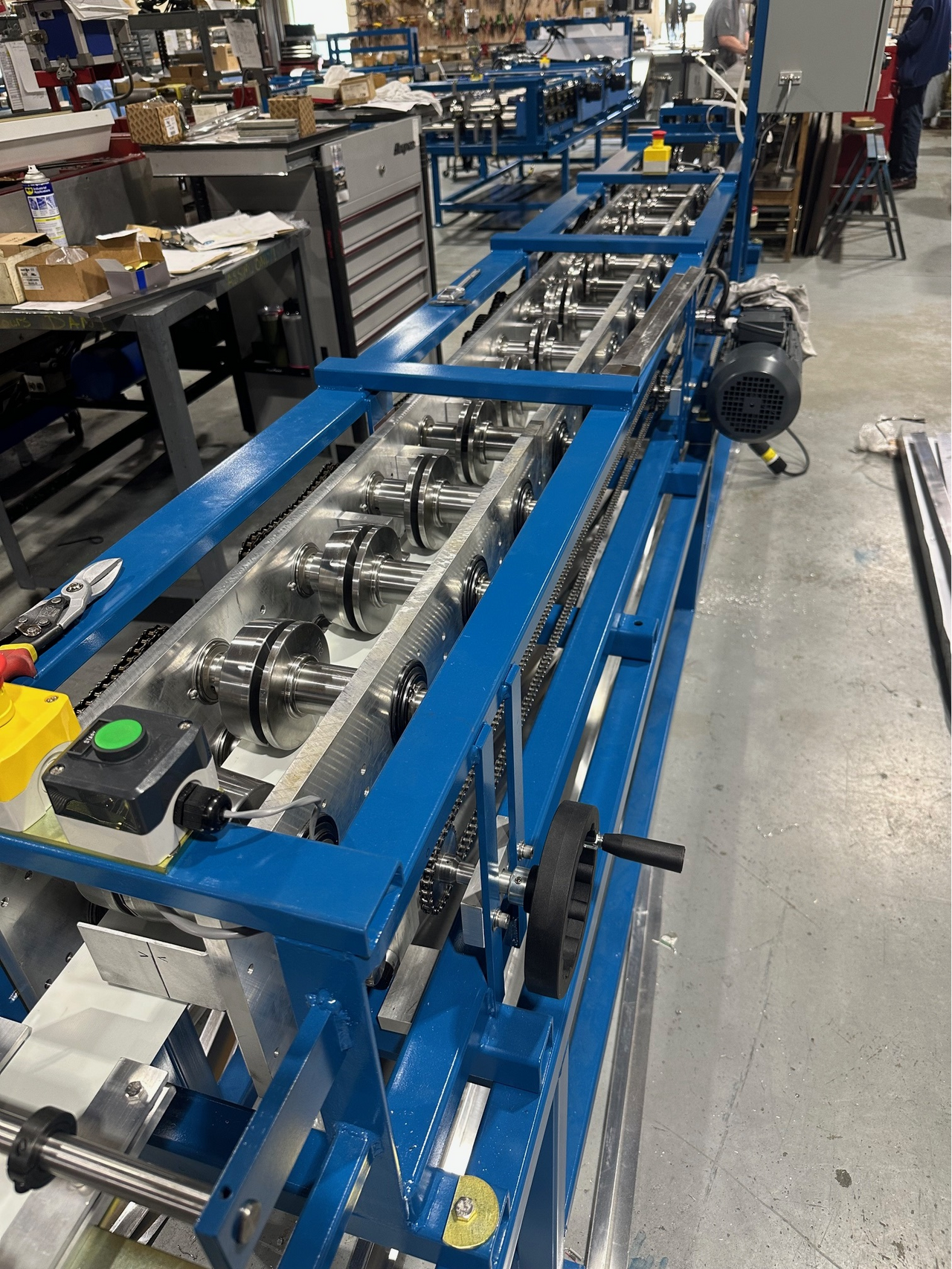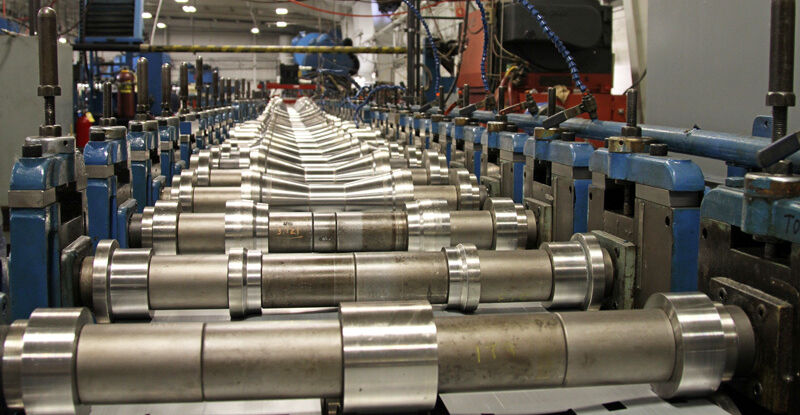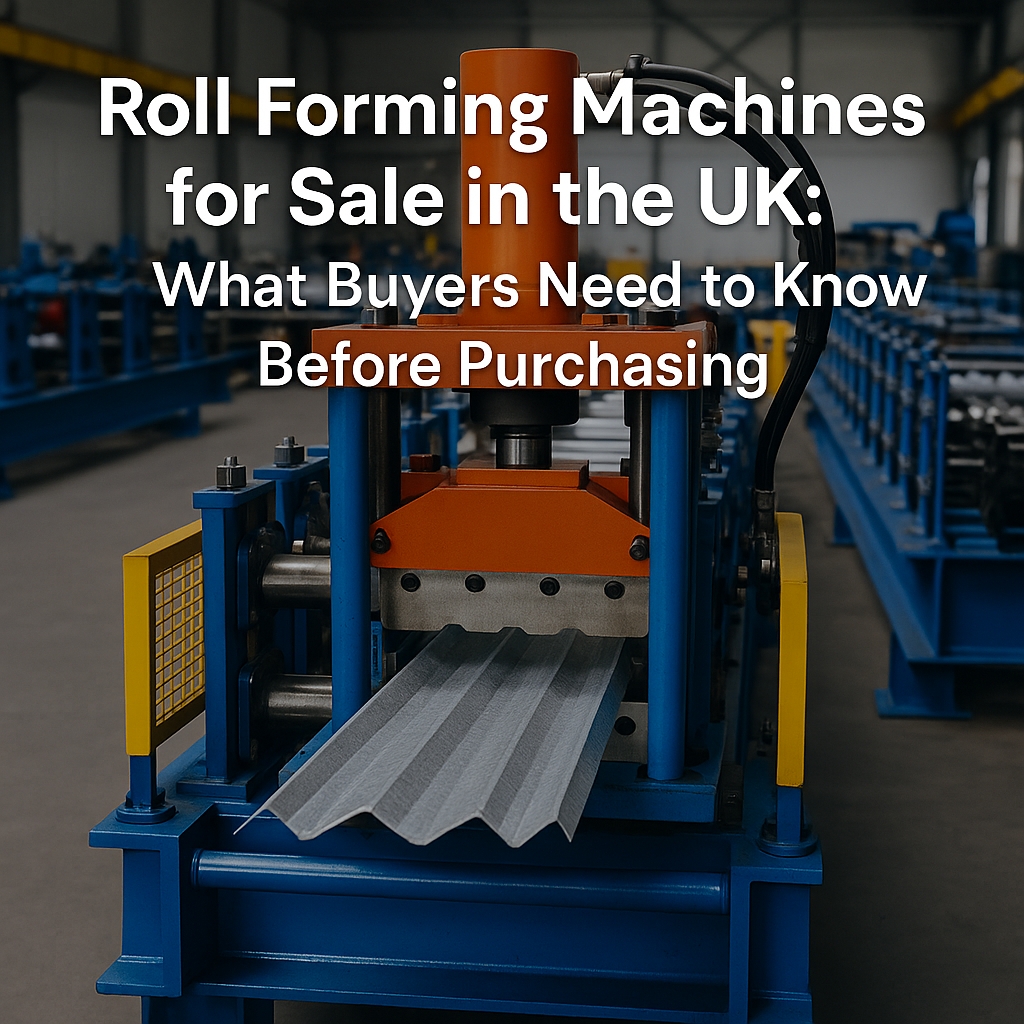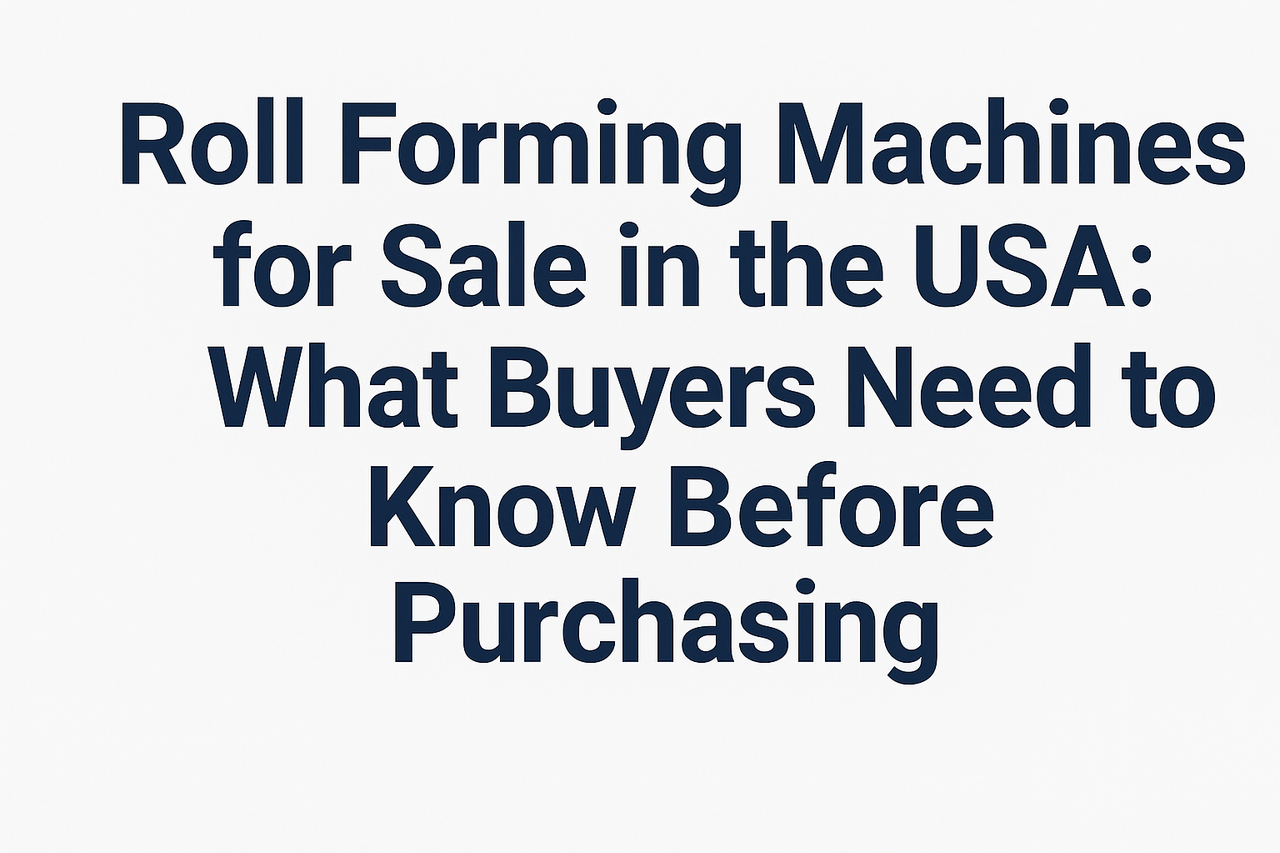C Channel Roll Forming Machines are widely used for manufacturing C purlins, steel framing, structural supports, and various types of channels for construction and industrial applications. If you're specifically focused on the U.S. market.
C Purlin roll forming machine specification
Here are the typical specifications for a C Purlin Roll Forming Machine. These machines are designed to produce C purlin profiles of varying sizes with high precision and efficiency.
Key Specifications:
- Material Specifications:
- Material Type: Galvanized steel, mild steel, or aluminum.
- Material Thickness: Typically between 1.5 mm to 3 mm (16 gauge to 11 gauge), but machines can often be customized for other thicknesses.
- Material Width: Typically between 100 mm to 300 mm, depending on the width of the purlin required.
- Machine Speed:
- Forming Speed: Typically around 10-20 meters per minute (33-66 feet per minute). High-speed machines can go up to 30 m/min.
- Cutting Speed: The cutting system is often hydraulic, with cutting accuracy being within ±1 mm.
- Production Range:
- Profile Range: C purlins typically range from 80 mm to 300 mm in height (web size).
- Flange Width: 40 mm to 80 mm.
- Lip Size: 12 mm to 25 mm.
- Length: Adjustable for producing purlins of various lengths, often ranging from 2 meters to 12 meters (6.5 feet to 39 feet).
- Roller and Shaft:
- Roller Material: High-grade GCr15 steel with hard chrome plating for durability and precision.
- Shaft Diameter: Usually between 70 mm and 90 mm depending on the machine's capacity and design.
- Forming Stations:
- Number of Rollers: Typically 14-20 forming stations, depending on the profile complexity and required accuracy.
- Shaft Drive: Chain drive or gearbox drive (gearbox is preferred for heavy-duty machines).
- Roller Stations: Adjustable to accommodate different profile sizes without needing a complete tool change.
- Control System:
- Automation: Fully automatic with PLC (Programmable Logic Controller) control for precision.
- PLC System: Usually equipped with a Siemens, Mitsubishi, or Delta PLC system for user-friendly operation and real-time monitoring.
- Touchscreen HMI: A touchscreen control panel (HMI - Human Machine Interface) for easy parameter setting and profile adjustments.
- Cutting Length Control: Set via the control system with precise measurement by encoders.
- Cutting System:
- Type: Hydraulic or servo motor-driven cutting system.
- Cutting Method: Flying cut-off or post-cut method with hydraulic pressure.
- Punching: Pre-punching or post-punching system for holes (round, oblong, or square). The punching system can be customized based on user requirements.
- Machine Dimensions:
- Length: 10-15 meters (33-49 feet) depending on the number of forming stations.
- Width: 1.5-2.5 meters (5-8 feet).
- Height: Around 1.5 meters (5 feet).
- Weight: Typically between 8-12 tons depending on the machine design.
- Power Supply:
- Motor Power: Usually between 11-22 kW, depending on machine capacity.
- Hydraulic Power: 5.5 kW to 7.5 kW for the cutting and punching system.
- Voltage: 380V/50Hz/3-phase or as per customer requirements.
- Auxiliary Equipment:
- Decoiler: A hydraulic decoiler or manual decoiler with a capacity of 5-10 tons.
- Runout Table: Automated or manual runout tables for receiving finished purlins.
- Hydraulic Station: Independent hydraulic station to power the cutting and punching operations.
- Coil Width: Adjustable for varying material widths, typically accommodating coils from 600 mm to 800 mm.
- Optional Features:
- Quick Change System: Some machines offer a quick-change system to switch between different profile sizes without significant downtime.
- C and Z Purlin Changeover: Some models allow for quick tool change between C purlin and Z purlin profiles.
- Punching System: Multiple hole patterns available with custom die design for project-specific needs.
Example Specification:
| Feature | Specification |
|---|
| Material Thickness | 1.5 mm to 3.0 mm |
| Forming Speed | 10-20 meters/min |
| Profile Height (H) | 80 mm to 300 mm |
| Flange Width (B) | 40 mm to 80 mm |
| Lip Size (L) | 12 mm to 25 mm |
| Number of Stations | 14-20 stations |
| Roller Material | GCr15 steel with hard chrome plating |
| Shaft Diameter | 70 mm to 90 mm |
| Motor Power | 11-22 kW |
| Hydraulic Power | 5.5 kW to 7.5 kW |
| Control System | PLC with touch screen (Siemens/Mitsubishi/Delta) |
| Cutting System | Hydraulic with flying cut-off or post-cut |
| Decoiler Capacity | 5-10 tons |
| Punching System | Pre-punch or post-punch, customizable patterns |
| Dimensions | 10-15 meters long, 1.5-2.5 meters wide, 8-12 tons weight |
Would you like further information on pricing or specific machine models?
C Purlin Profiles are metal structural components used primarily in construction for supporting roofs, walls, and floors in steel building systems. These profiles are shaped like the letter "C" when viewed from the end and are made from steel or aluminum, typically formed by a roll forming machine.
Here are the key details about C Purlin Profiles:
Common Dimensions and Sizes
C purlins are available in various dimensions, depending on the structural requirements of the building. Here are some typical measurements:
- Height (H): The height of the web section (vertical part of the "C") typically ranges from 4 inches (100 mm) to 12 inches (300 mm).
- Flange Width (B): The width of the flanges (horizontal parts of the "C") usually varies from 1.5 inches (40 mm) to 3 inches (75 mm).
- Lip (L): The lip on the edges of the flanges is usually between 0.5 inches (12 mm) and 1 inch (25 mm).
- Thickness (T): The material thickness varies from 1.6 mm (16 gauge) to 3 mm (11 gauge), depending on the load requirements and material strength.
C Purlin Profile Diagram:
cssCopy code<code> _________ B
| |
| |
| H |
| |
|_________|__
L
</code>
Common C Purlin Profiles and Applications
- Light C Purlins (smaller H and B dimensions):
- Application: Commonly used in light steel framing for smaller structures such as garages, sheds, and smaller industrial buildings.
- Height: Typically between 4 inches (100 mm) and 6 inches (150 mm).
- Thickness: 1.5 mm to 2 mm.
- Heavy C Purlins (larger H and B dimensions):
- Application: Used in larger steel structures, like industrial buildings, warehouses, and large roofing systems.
- Height: Ranges from 6 inches (150 mm) to 12 inches (300 mm).
- Thickness: 2.5 mm to 3 mm.
- Punching Patterns:
- Applications: C purlins are often pre-punched with holes for easier installation on-site. These holes can be round, oblong, or square and are positioned based on the connection details.
- Custom: Punching can be customized to meet the specific structural needs and design specifications.
Material Types:
- Galvanized Steel: This is the most common material for C purlins, as it offers high strength and corrosion resistance, making it ideal for outdoor applications and areas with high humidity.
- Aluminum: Less common but sometimes used for lightweight applications where corrosion resistance is key, but the structure doesn’t need to support heavy loads.
C Purlin Applications:
- Roof Purlins: Used to support roof sheeting in both low and high-pitched roofs. The C shape offers excellent resistance to downward forces from the roof load.
- Wall Girts: Installed horizontally to support cladding or siding, C purlins function as girts in metal-framed wall systems.
- Floor Joists: For mezzanine floors or lightweight floors, C purlins can be used as structural members.
Advantages of C Purlin Profiles:
- Lightweight: They are lighter than other structural elements like I-beams, making them easier to install and more cost-effective for transportation.
- Customizable: The profiles can be customized based on specific building needs, including variations in height, width, lip size, and punching patterns.
- Strength: Despite their lightweight nature, C purlins are strong enough to support roofing, walling, and even flooring in various building types.
- Cost-Effective: Because of their design, they are a more economical choice for many construction applications compared to heavier structural materials.
Machine matcher specialise in matching your roll forming machine requirements with the perfect new or pre owned machine.
We partner with, and represent some of the finest roll forming manufacturers in the market. For more information and a free machine quote please contact us today or view all machines.
